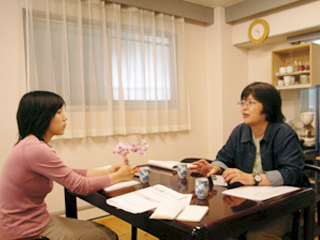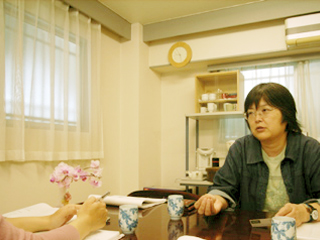 Izumi NIKI
Izumi NIKI
Graduate Student, ICU
【The full text of this article is not available yet. We apologize for the inconvenience. The summary below is the same as the article that appears in the eighth issue of the CGS Newsletter.】
The Action Center for Working Women (ACW2) was founded on January 20, 2007, as the first nationwide support organization for female workers which allows individual participation. What does the launch of a women-only organization signify? I interviewed ACW2 representative Ms. Midori Ito, weighted down by a sense of “resignation” that seems to be hanging over us all.
■Under ACW2 policy, the organization is involved in many activities for the support of working women; from support for individual conflict resolution to awareness education. But what is the difference between ACW2 and other local labour unions (women’s unions) which are based on individual membership?
According to Ms. Ito, “The women’s union is a labor union, so it helps people to negotiate with corporations to find resolution for various occupational problems such as sexual harassment or redundancy. Through this “collective bargaining,” unions uphold the Trade Union Law. However, Ms. Ito says that by the time most of their clients finally reach the Union, “they are at the end of their tether after being given the run-around by various consultation offices.” The centre was established as a “flag” to guide those who don’t know where to go. She says that, “(ACW2) was created as an adhesive to connect each individual working woman to the Union.” Their immediate objectives for the future are to provide information through the “Helpline for Working Women” which took place this May, and to conduct awareness education programs.
■The condition for entry to ACW2 is for “(the member’s) self-acknowledged sex to be female,” yet now that the distinction between male/female can no longer be considered fundamentally universal, why has the centre decided to restrict itself to females? Ms. Ito wryly smiled and admitted that she is often asked that question. But she explained that “although people claim equality of the sexes, discrimination within socially-created gender roles still exists.” “It is the same for the current wage system. Although it is said that different payment systems for men and women are no more, discrimination against those who are forced into the female category still exists.” She also adds that although women are beginning to enter into a diverse range of occupational fields, it still is not “gender-equal.” “For example, even if a woman becomes a truck driver, her wages are not increased. It would make sense to raise a woman’s salary to equal that of a man’s, but what they do is lower it to a female wage. The so-called ‘rise of the female workforce’ or ‘the mainstreaming of women’ is just a way of sweating cheap labor power for longer hours. If they really wanted to strengthen the female work force, then they ought to give them a raise.”
Yet the current unionization rate is 18%. Additionally, it is male-oriented, and ‘labor unions have not done their best to solve women’s concerns of pregnancy, child-birth, sexual harassment, wage inequality or irregular employment.’ That is why Ms. Ito started Women’s Union Tokyo. However, there were problems which even a women’s union could not resolve. An example of this is the situation of “women in society believing that they are the inferior sex, and degrading their own sex.”
“When asked which sex they’d rather be if they were to be reincarnated, an alarming number of women reply ‘in the end, it’s better to be male.’ We need a caucus, an independent group, in order to empower these women, to show them how to regain pride in themselves, and to realize their true strengths. But, when men and women work together, it seems that the men always seem to take the cherry, perhaps, because, men have a stronger influence or because they are more experienced socially. We want to give these women a chance to take affirmative action.” In order to do this, it was ncecessary for women and women’s unions in the country to form a network. The establishment of ACW2 as an “adhesive” was a response to this need.
 ■Although ACW2 is a centre for women, Ms. Ito says that there is something she wants to convey to men as well.
■Although ACW2 is a centre for women, Ms. Ito says that there is something she wants to convey to men as well.
“Some people say that it is difficult to be a male, with all these long working hours. There are also people who say that it is harrowing to be told to work longer hours than women, because they are men or not to take part in child-rearing. That’s why I think that people like us need to send out messages like ‘working long hours is not what makes you manly’ or that it’s not so important, and not following these strictures won’t take away their masculinity.”
■Over the past 16 years since the burst of the economic bubble, Ms. Ito says that society and corporations have become even stranger. Yet, she also says that she has “hope in the young people in their 20’s,” because of their upbringing within those severe circumstances.
“I went to a youth mayday rally, and it was so interesting. There were people who were really poor, the kind of people who had become something like‘McDonald refugees’ or ‘Net Café refugees’ (in reference to those people, mainly youths, who spend their nights in 24-hour facilities such as McDonalds or Net Cafés) trying to make a connection in their own way with each other – for the sake of their existence – instead of staying cooped up in their homes. In them I have much hope. Young people have both energy and power, and can start over again even if they fail.”
She prays that those people will be able to live a balanced life, enjoying their work, life and time-off in their own youth-like fashion, without being affected by the corporate system. She believes that “the people who are going to enter the work force in future need to protect their work conditions, and not leave it to other people. This is why unions and the center exist; simply having somewhere to access makes a difference.”
■There are currently 390-odd members in ACW2. Ms. Ito laughs that it is a long-way from the aim of ten thousand members. Yet, she thinks that there are many latent possibilities. Recently, “groups for poor youths and migrant workers” contacted the ACW2. Although she prefaces that it may be wishful thinking, Ms. Ito feels that “within this social divide, those who were former adversaries such as men and women, or migrant workers and Japanese people are now starting to join hands and understand each other.”
There were some calls from men to the helpline established in May. Ms. Ito says that, “in earlier days, there were many of sexual harassment calls just because of the word ‘women’ attached to the helpline. Although this may be a coincidence, this time there were none. Perhaps a kind of division has arisen within males, or a mutual understanding has developed – there were calls asking if they could call the female hotline, even if they were male. I feel a great potential in cases like this.”
What should both men and women do to live a “normal” life? Seeing Ms. Ito’s expectations of new alliances within the social divide, I also felt encouraged to take action. In order to overcome this “sense of resignation” towards society, it is vital for each and every one of us not to give up.